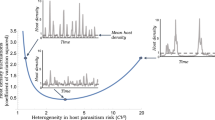Summary
Simulation models have recently been used to suggest that spatial heterogeneity, acting on small spatial scales within local populations, may allow parasitoids and other natural enemies to “regulate” host or prey populations in ways that would not be detected by conventional (k-factor) analyses of life table data. However, additional study of these models suggests that local extinction may be a frequent event in the simulated interactions. The “spreading of risk” concept appears more applicable to the simulated populations than a classical view emphasizing tight regulation around stable equilibrium points. The spreading of risk viewpoint also appears to shed additional light on questions raised in the recent debate between Dempster (1983); Hassel (1985); Dempster and Pollard (1986), concerning the modeling of spatial heterogeneity and “regulation” in temperate-zone insect populations.
Similar content being viewed by others
References
Andrewartha HG, Birch LC (1954) The Distribution and Abundance of Animals. University of Chicago Press, Chicago
Beddington JR, Free CA, Lawton JH (1976) Concepts of stability and resilience in predator-prey models. J Anim Ecol 45:791–816
Chesson PL (1978) Predator-prey theory and variability. Ann Rev Ecol Syst 9:323–347
Chesson PL, Murdoch WW (1986) Aggregation of risk: Relationships among host-parasitoid models. Am Nat 127:696–715
Connell JH, Sousa WP (1983) On the evidence needed to judge ecological stability or persistence. Am Nat 121:789–824
Crowley PH (1981) Dispersal and the stability of predator-prey interactions. Am Nat 118:673–701
Dayton PK (1971) Competition, disturbance and community organization: the provision and subsequent utilization of space in a rocky intertidal community. Ecol Monogr 41:351–389
Dempster JP (1983) The natural control of populations of butterflies and moths. Biol Rev 58:461–481
Dempster JP, Pollard E (1986) Spatial heterogeneity, stochasticity and the detection of density dependence in animal populations. Oikos 46:413–416
den Boer PJ (1968) Spreading of risk and stabilization of animal numbers. Acta Biotheoretica 18:165–194
den Boer PJ (1981) On the survival of populations in a heterogeneous and variable environment. Oecologia (Berlin) 50:39–53
Ehrlich PR (1965) The population biology of the butterfly, Euphydryas editha. II. The structure of the Jasper Ridge colony. Evolution 11:327–336
Fahrig L, Merriam G (1985) Habitat patch connectivity and population survival. Ecology 66:1762–1768
Gurney WSC, Nisbet RM (1978) Predator-prey fluctuations in patchy environments. J An Ecol 47:85–102
Hassell MP (1978) The Dynamics of Arthropod Predator-Prey Systems. Princeton University Press, Princeton
Hassell MP (1985) Insect natural enemies as regulating factors. J Anim Ecol 54:323–334
Hastings A (1977) Spatial heterogeneity and the stability of predator-prey systems. Theor Popul Biol 12:37–48
Hastings A (1978) Spatial heterogeneity and the stability of predator-prey systems: Predator-mediated coexistence. Theor Popul Biol 14:380–395
Holling CS (1973) Resilience and stability of ecological systems. Ann Rev Ecol Syst 4:1–23
Levin SA (1976) Population dynamics in heterogeneous environments. Ann Rev Ecol Syst 7:287–310
May RM (1978) Host-parasitoid systems in patchy environments: A phenomenological model. J Anim Ecol 47:833–843
Maynard Smith J (1974) Models in Ecology. Cambridge University Press, Cambridge
Murdoch WW, Reeve JR, Huffaker CB, Kennett CE (1984) Biological control of olive scale and its relevance to ecological theory. Am Nat 123:371–392
Murdoch WW, Chesson J, Chesson PL (1985) Biological control in theory and practice. Am Nat 125:344–366
Pickett STA, White PS (1985) The Ecology of Natural Disturbance and Patch Dynamics (eds). Academic Press, Orlando
Price PW (1980) Evolutionary Biology of Parasites. Princeton University Press, Princeton
Reddingius J, den Boer PJ (1970) Simulation experiments illustrating stabilization of animal numbers by spreading of risk. Oecologia (Berlin) 5:240–284
Roff DA (1974) The analysis of a population model demonstrating the importance of dispersal in a heterogeneous environment. Oecologia (Berlin) 15:259–275
Vandermeer JH (1973) On the regional stabilization of locally unstable predator-prey relationships. J Theor Biol 41:161–170
Author information
Authors and Affiliations
Rights and permissions
About this article
Cite this article
Morrison, G., Barbosa, P. Spatial heterogeneity, population “regulation” and local extinction in simulated host-parasitoid interactions. Oecologia 73, 609–614 (1987). https://doi.org/10.1007/BF00379424
Received:
Issue Date:
DOI: https://doi.org/10.1007/BF00379424




